FORT BRAGG, N.C. — Successful implementation of new body armor technology requires more than just engineers designing prototype systems in a lab. Feedback from Soldiers who will be using the technology is critical to ensuring that the U.S. Army continues to field world-class technology for its fighters.
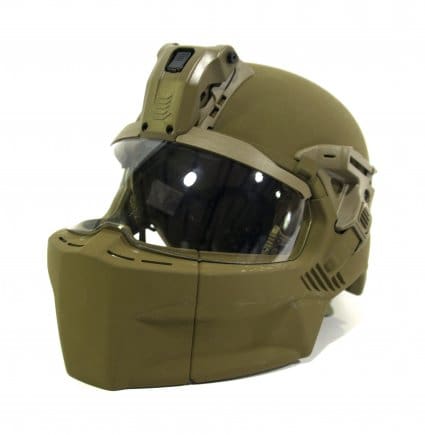
The new Integrated Head Protection System (IHPS) is configured with mandible and visor without ballistic applique for “Rough Terrain” static line parachute jump operations. (Photo Credit: Rebecka Waller, Audio Visual Production Specialist, Airborne and Special Operations Test Directorate, U.S. Army Operational Test Command)
Recently, Airborne Soldiers here played a vital part in the feedback process when they recently jumped with a groundbreaking new Integrated Head Protection System (IHPS) during operational testing.
Soldiers from the 57th Sapper Company, 27th Engineer Battalion, 20th Engineer Brigade, geared up to work with the U.S. Army Operational Test Command’s Airborne and Special Operations Test Directorate to test the new armor.
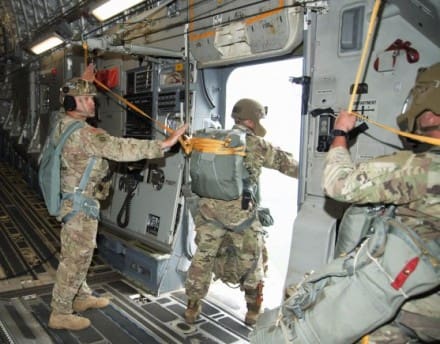
1st Lt. Christopher Lillie, assistant jumpmaster with the 57th Sapper Company, 27th Engineer Battalion, 20th Engineer Brigade, wears the new Integrated Head Protection System (IHPS) helmet with mandible, while shouting commands to position the number one jumper in the door of a C-17 aircraft. (Photo Credit: Barry Fischer, Audio Visual Production Specialist, Airborne and Special Operations Test Directorate, U.S. Army Operational Test Command)
“Operational Testing is about Soldiers. It is about making sure that the systems developed are effective in a Soldier’s hands and suitable for the environments in which Soldiers train and fight,” said Col. Brad Mock, director of ABNSOTD.
The IHPS is one of the six components of the Soldier Protection System (body armor), providing a larger area of protection for the head and face, and includes a system to measure head trauma.

Soldier configured with the new Integrated Head Protection System (IHPS) without the mandible, while wearing combat equipment. (Photo Credit: Rebecka Waller, Audio Visual Production Specialist, Airborne and Special Operations Test Directorate, U.S. Army Operational Test Command)
According to Leon L. Price, a test officer with ABNSOTD, the purpose of operational test using Airborne paratroopers is to collect data to evaluate the suitability and safety of the IHPS when worn during static line Airborne operations.
Overall, IHPS is only a little lighter than the current Army Combat Helmet, while including numerous accessories, like a mandible, visor, night vision goggle attachment device, rails and a modular ballistic applique (not attached during airborne operations).

Soldier configured with the new Integrated Head Protection System (IHPS) with the mandible, while wearing combat equipment. (Photo Credit: Rebecka Waller, Audio Visual Production Specialist, Airborne and Special Operations Test Directorate, U.S. Army Operational Test Command)
During the test, Soldiers participated in New Equipment Training, which included familiarization, fitting, and suspended harness. All this was followed by a live parachute jump from a C-17 high performance aircraft at 1,250 feet above ground level over Fort Bragg’s Sicily Drop Zone.
“I gave fair, honest and comprehensive feedback on the IHPS helmet,” said Cpl. Samuel Emling, a Combat Engineer with the 57th. “I enjoyed the testing. The test personnel were extremely professional.”
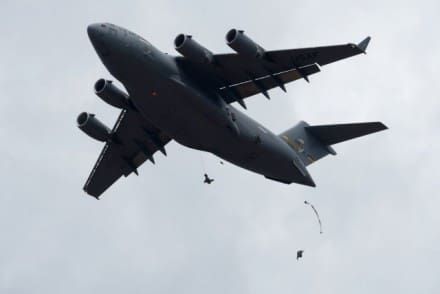
Soldiers from the 57th Sapper Company, 27th Engineer Battalion, 20th Engineer Brigade, exit a C-17 aircraft over Sicily Drop Zone, Fort Bragg, North Carolina, while performing operational testing wearing the new Integrated Head Protection System (IHPS). (Photo Credit: Jim Finney, Combined Technical Services, Airborne and Special Operations Test Directorate, U.S. Army Operational Test Command)
“Soldiers and test units have the ability to impact the development of systems by training while executing doctrinally-realistic missions, and then provide direct input to the combat developer of the system,” said Lt. Col. Vinny Intini, executive officer at ABNSOTD. “Their feedback is invaluable.”
Test Manager Steve McNair, of Program Manager Soldier Protection and Individual Equipment out of Fort Belvoir, Virginia, said the Army is expected to field 7,000 systems to separate brigades during fiscal year 2018 before moving to full rate production for fielding across the force.
“I think I benefitted personally by doing this,” said Spec. Aaron Adams, another Combat Engineer with the 57th. “It helps me with being comfortable jumping with new equipment. I enjoyed participating in the testing because we were the only Airborne unit to do so.”
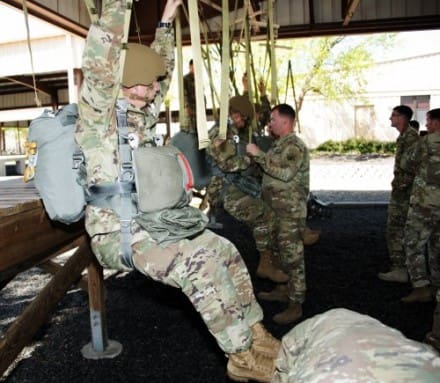
Soldiers participate in suspended harness training to ensure the new Integrated Head Protection System (IHPS) is suitable when performing canopy control and emergency procedures during operational testing. (Photo Credit: Michael Zigmond, Audio Visual Production Specialist, Airborne and Special Operations Test Directorate, U.S. Army Operational Test Command)
“OTC is the U.S. Army’s only independent operational test organization,” Mock added. “Any time Soldiers and their leaders get involved in operational testing, they have the opportunity to use, work with, and offer up their own suggestions on pieces of equipment that can impact development of systems that future Soldiers will use in combat.”
“Operational testing is OTC’s opportunity to contribute to readiness; anything less compromises the Army’s ability to provide the forces that fight and win the Nation’s wars,” added Intini.
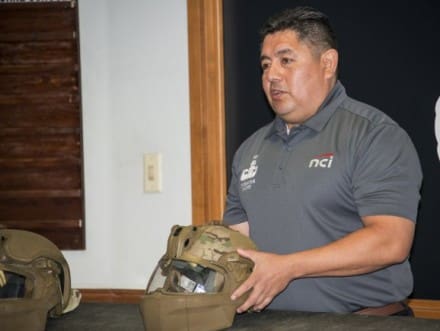
Bobby Salazar, from Program Manager Soldier Protection and Individual Equipment, out of Fort Belvoir, Virginia, discusses proper fitting of the new Integrated Head Protection System (IHPS) during New Equipment Training. (Photo Credit: Michael Zigmond, Audio Visual Production Specialist, Airborne and Special Operations Test Directorate, U.S. Army Operational Test Command)
The U.S. Army Operational Test Command is based at West Fort Hood, Texas, and its mission is about making sure that systems developed are effective in a Soldier’s hands and suitable for the environments in which Soldiers train and fight. Test units and their Soldiers provide feedback, by offering input to improve upon existing and future systems with which Soldiers will ultimately use to train and fight.
The Fort Bragg, North Carolina-based ABNSOTD plans, executes, and reports on operational tests and field experiments of Airborne and Special Operations Forces equipment, procedures, aerial delivery and air transportation systems in order to provide key operational data for the continued development and fielding of doctrine, systems or equipment to the Warfighter.


Perhaps someone in the airborne community can answer this question. Why doesn’t the US military parachutists wear similar safety gear that US Forest Service Smoke Jumpers wear when operating in wooded terrain? If my study of history is correct, Smoke Jumpers predate US Army paratrooper by a few years and have mastered jumping into heavily foliaged terrain. I know Smoke Jumpers rely heavily on technology, especially chute technology, from the US Military but I would hope this exchange is a two way street. After all the “three ring” and direct deployment set up we see today came from the civilian jump community pioneered by Steve Booth.
I think we were posting at the same time, but the rough-terrain equipment is essentially the same as smoke jumper equipment.
As far as chute technology, the SF-10A, now the MC-6, is a chute developed by the forest service.
Why don’t they? They do use it, as do some of our allied nations, I’ve seen both first hand.
Former JM. Because, we need to put the maximum number of troops into an area, hopefully not over trees. Can’t be very combat effective if 50%+ of your troops are in the trees. Also rough-terrain kit isn’t conducive to hit the ground and put your weapon into operation. Prime Real Estate are airfields so the air land can follow. Jump status for 24 years.
Former parachute rigger here. Smoke jumpers wear a hockey mask kinda face shield. And tre landings (have had one). Are the worst thing when you are carrying a 60mm mortar baseplate, a javelin, or a crewserve weapon. Your team needs that equipment asap. And when your stuck in the trees you are now combat ineffective! Not only that but if your gear is stuck higher up then you, or you are stuck to high to get yourself free from the trees. Now not only are you combat ineffective but so is everyone who has to help you get out of the trees.
Every rough terrain team I have ever seen jump based their load on IPB. If the trees were tall, they had ropes to lower themselves. If the trees were low, they most likely still had the same. If you are jumping rough terrain, you tailor to the mission, if you aren’t doing so, you will most likely pay for your mistake in time and lives. RT is not an airfield seizure, it is a very specific mission for a very specific type of unit (meaning one trained for it, ie has conducted rehearsal jumps on numerous occasions).
Not sure how it’s done now, but 15 years ago, this was a commonly rehearsed mission for certain units, elements of the 27th Engineers (ABN) (out of FBNC) included.
57th Sapper Company, 27th Engineer Battalion. Is this the rough terrain company? If so, I could see the full-face ballistic helmet replacing the current helmet/cage.
Yes, the 57th is the rough terrain company. I would assume they were chosen for the test specifically due their experience jumping with the rough terrain helmets
With that jawline I fully expect, no demand, one painted to look like Bruce Campbell!
Or Stan Smith from American Dad
Jay Leno…..the possibilities are numerous.
I was thinking either Baron Werner Underbheit from The Venture Bros. or Doctor Doom! Lol
Here’s the thing, I’m not sure what problem the IHPS is designed to solve. The ECH and ACH-II are existing solutions for protection and weight issues that integrate with current equipment seamlessly, and an ACH appliqué would further simplify logistics and streamline protection issues.
The IHPS isn’t unique. Furthermore, ballistic mandibles have been out for a while and as of yet, I don’t know if anyone has solved the issues of being able to A) breath while using one (because I can easily see these things causing excellent aged cases of heatstroke and exceptionally poor oxygenation) or B) getting any kind of a cheek weld while wearing one. Additionally, you can’t use NOD’s with the visor since they use the same mount so you would still need to issue goggles right?
It honestly seems like the IHPS creates more problems than it solves and is inferior to the ACH-II which the Army got very right.
When I rock a mandible I use my fast helmet and the ops-core mandible. It’s flexible and I can get a cheek wield. The breathing problem is only when I’m riding my quad and trying to shoot (once I come to a stop). But that’s because my adrenaline is pumping hard and I’m usually wearing my ballistic vest too! Easiest way to carry everything without having to carring a bag and digging thru it. I might be called a rent-a-cop. But on my property. It’s easier for me (I’m a paraplegic)! To use my gear that I was issued when I deployed. (I wasn’t issued the normal stuff btw)
Correct me if I’m worn SSD, but isn’t this helmet specifically for the rough terrain jumpers?
If so, their requirements are going to be different than a Paratrooper’s in the conventional Airborne unit.